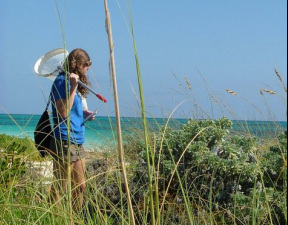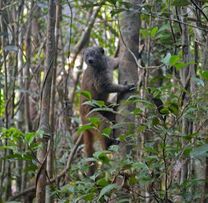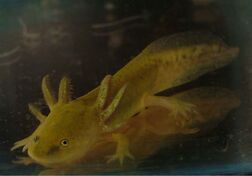New project: Evolution of a gene family involved in detoxificationIn 2021 I received an NSF postdoctoral fellowship to work on a new project studying the structural and functional evolution of the cytochrome P450 gene family in woodrats (genus Neotoma). This project is advised by Dr. Marjorie Matocq at the University of Nevada Reno and is a part of the Genomes Underlying Toxin Tolerance (GUTT) community (NSF OIA 1826801). This project is just beginning! It will use genomic and transcriptomic datasets.
the influence of data type on Species tree reconstruction: A study of strepsirrhine primates |
Are you a student applying for the NSF Graduate Research Fellowship this year? Here are my successful 2014 materials:
|
|
I was a recipient of the University of Kentucky's (UK) University Research Postdoctoral Fellowship. My highly collaborative research out of the Weisrock Lab focuses on species tree reconstruction in strepsirrhines: a group of primates that includes Madagascar's lemurs as well as the lorises and galagos of continental Africa. I am using a next-gen sequencing dataset containing loci have different functional properties (e.g., some loci are under selection while others are neutrally evolving). My research will reconstruct the evolutionary history of strepsirrhines, but will also analyze how these differences in loci influence species tree reconstruction. Publications pending.
|
factors shaping population structure in tiger salamanders
|
As a postdoc at the University of Kentucky, I co-led a project on the North American tiger salamander species complex with Dr. Levi Gray (senior author Dr. Dave Weisrock). Tiger salamanders (Ambystoma spp.) are a radiation containing species that metamorphose from aquatic larvae to terrestrial adults (top photo on the right), while other species retain an aquatic larval form their entire life (bottom photo on the right, and including the famous axolotl). Unexpectedly, we found that ecology and life history had little effect on reproductive isolation; rather, speciation appears to have been primarily driven by geography and landscape features.This project was published in PNAS in 2021.
Everson, KM*, Gray, LN*, Jones, AG†, Lawrence, NM, Foley, ME, Sovacool, KL, Kratovil, JD, Hotaling, S, Hime, PM, Storfer, A, Parra-Olea, G, Percino-Daniel, R, Aguilar-Miguel, X, Zambrano, L, Shaffer, HB, and DW Weisrock. “Geography is more important than life history in the recent diversification of the tiger salamander complex.” PNAS 118(17): e2014719118. doi: 10.1073/pnas.2014719118 *these authors contributed equally to this work |
My dissertation: the evolutionary history of madagascar's tenrecs
My PhD research with the Olson Lab in the University of Alaska Museum Mammals Collection focused on phylogeography and species delimitation in Madagascar's tenrecs. A tenrec is any species in the mammal family Tenrecidae, only found on the island-country of Madagascar. Below are the references for my four published dissertation chapters as well as a co-authored assessment of the conservation status of tenrecs.
Chapter 1:
Everson, KM, V Soarimalala, SM Goodman, and LE Olson. 2016. “Multiple loci and complete taxonomic sampling resolve the phylogeny and biogeographic history of tenrecs (Mammalia: Tenrecidae) and reveal higher speciation rates in Madagascar’s humid forests.” Systematic Biology 65(5): 890-909.* doi:10.1093/sysbio/syw034
*featured on cover; received Publisher’s Award for Excellence in Systematic Research
Chapter 2:
Everson, KM, KBP Hildebrandt, SM Goodman, and LE Olson. 2018. “Caught in the act: incipient speciation across a latitudinal gradient in a semifossorial mammal from Madagascar, the mole tenrec Oryzorictes hova (Tenrecidae).” Molecular Phylogenetics and Evolution 126:74-84. doi:10.1016/j.ympev.2018.02.024
Chapter 3:
Everson, KM, SA Jansa, SM Goodman, and LE Olson. 2020. “Montane regions drive recent diversification in small mammals and reptiles from Madagascar’s humid forest.” Journal of Biogeography 47(10): 2059-2072.* doi:10.1111/jbi.13945
*Featured as the Editor’s Choice article
Chapter 4:
Everson, KM, SM Goodman, and LE Olson. 2020. “Speciation and gene flow in two sympatric mammals from Madagascar, Microgale fotsifotsy and M. soricoides (Mammalia: Tenrecidae).” Molecular Ecology 29(9): 1717-1729. doi:10.1111/mec.15433
Conservation assessment of tenrecs:
Stephenson, PJ, V Soarimalala, SM Goodman, M Nicoll, V Andrianjakarivelo, KM Everson, M Hoffmann, P Jenkins, LE Olson, M Raheriarisena, F Rakotondraparany, D Rakotondravony, V Randrianjafy, N Ratsifandrihamanana, A Taylor. 2021. “Review of the status and conservation of tenrecs (Mammalia: Afrotheria: Tenrecidae).” Oryx 55(1):13-22.* doi: 10.1017/S0030605318001205
*featured on cover
Chapter 1:
Everson, KM, V Soarimalala, SM Goodman, and LE Olson. 2016. “Multiple loci and complete taxonomic sampling resolve the phylogeny and biogeographic history of tenrecs (Mammalia: Tenrecidae) and reveal higher speciation rates in Madagascar’s humid forests.” Systematic Biology 65(5): 890-909.* doi:10.1093/sysbio/syw034
*featured on cover; received Publisher’s Award for Excellence in Systematic Research
Chapter 2:
Everson, KM, KBP Hildebrandt, SM Goodman, and LE Olson. 2018. “Caught in the act: incipient speciation across a latitudinal gradient in a semifossorial mammal from Madagascar, the mole tenrec Oryzorictes hova (Tenrecidae).” Molecular Phylogenetics and Evolution 126:74-84. doi:10.1016/j.ympev.2018.02.024
Chapter 3:
Everson, KM, SA Jansa, SM Goodman, and LE Olson. 2020. “Montane regions drive recent diversification in small mammals and reptiles from Madagascar’s humid forest.” Journal of Biogeography 47(10): 2059-2072.* doi:10.1111/jbi.13945
*Featured as the Editor’s Choice article
Chapter 4:
Everson, KM, SM Goodman, and LE Olson. 2020. “Speciation and gene flow in two sympatric mammals from Madagascar, Microgale fotsifotsy and M. soricoides (Mammalia: Tenrecidae).” Molecular Ecology 29(9): 1717-1729. doi:10.1111/mec.15433
Conservation assessment of tenrecs:
Stephenson, PJ, V Soarimalala, SM Goodman, M Nicoll, V Andrianjakarivelo, KM Everson, M Hoffmann, P Jenkins, LE Olson, M Raheriarisena, F Rakotondraparany, D Rakotondravony, V Randrianjafy, N Ratsifandrihamanana, A Taylor. 2021. “Review of the status and conservation of tenrecs (Mammalia: Afrotheria: Tenrecidae).” Oryx 55(1):13-22.* doi: 10.1017/S0030605318001205
*featured on cover
patterns of gene flow in thrushes (Catharus)
|
I was first-author on a study out of Dr. Kevin Winker's lab in the ornithology department of the University of Alaska Museum. The study focused on speciation and gene flow in a lineage of birds containing both migratory and non-migratory species, and it used a high-throughput DNA sequencing dataset for demographic modeling. It was published in 2019:
Everson, KM, McLaughlin, JF, Cato, IA, Evans, MM, Gastaldi, AR, Mills, KK, Shink, KG, Wilbur, SM, and Winker, K. 2019. “Speciation, gene flow, and seasonal migration in Catharus thrushes." Molecular Phylogenetics and Evolution 139:106564. doi:10.1016/j.ympev.2019.106564 |
Early research experiences

photo credit: Dr. Carol Landry
My senior honors thesis as an undergraduate was a study of the evolution and geographical distribution of the Woolly Mouse Opossum (Marmosa demerarae), a small South American marsupial. Working at the University of São Paulo (USP) with Dr. Alexandre Percequillo, we showed that populations on either side of the Madeira River in the Amazon rainforest are morphologically and genetically distinct. I presented my research at the 2012 Denman Undergraduate Research Forum and published my complete thesis with The Ohio State University.
In 2011 I conducted an independent research project on the reproductive biology of Bay Lavender, a common dune plant on San Salvador Island in the Bahamas (advisor Carol Landry). I concluded that Bay Lavender serves as a key foraging plant for at least 12 insect species from three orders and that self-compatibility makes Bay Lavender a good pioneer species, with the ability to colonize new dunes with just one or a few individuals (especially important after a hurricane).
During my first two years at Ohio State (2009-2010) I worked as a Research Assistant in Dr. Kristin Mercer's Plant Evolutionary Ecology Lab, where I participated in studies of gene flow and hybridization between wild and domesticated sunflowers. I also worked as a Research Assistant in Dr. James Bauer's Aquatic Biogeochemistry Lab during my last two years of college (2011-2012). There I learned carbon dating and nutrient analysis methods and used them to study organic and inorganic inputs to aquatic systems. Finally, I spent my summers as an undergraduate working as an assistant at OSU's F.T. Stone Laboratory and Biological Field Station on Gibraltar Island in Lake Erie.
In 2011 I conducted an independent research project on the reproductive biology of Bay Lavender, a common dune plant on San Salvador Island in the Bahamas (advisor Carol Landry). I concluded that Bay Lavender serves as a key foraging plant for at least 12 insect species from three orders and that self-compatibility makes Bay Lavender a good pioneer species, with the ability to colonize new dunes with just one or a few individuals (especially important after a hurricane).
During my first two years at Ohio State (2009-2010) I worked as a Research Assistant in Dr. Kristin Mercer's Plant Evolutionary Ecology Lab, where I participated in studies of gene flow and hybridization between wild and domesticated sunflowers. I also worked as a Research Assistant in Dr. James Bauer's Aquatic Biogeochemistry Lab during my last two years of college (2011-2012). There I learned carbon dating and nutrient analysis methods and used them to study organic and inorganic inputs to aquatic systems. Finally, I spent my summers as an undergraduate working as an assistant at OSU's F.T. Stone Laboratory and Biological Field Station on Gibraltar Island in Lake Erie.






